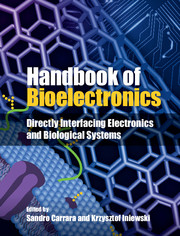Book contents
- Frontmatter
- Contents
- List of Contributors
- 1 What is bioelectronics?
- Part I Electronic components
- Part II Biosensors
- Part III Fuel cells
- Part IV Biomimetic systems
- Part V Bionics
- Part VI Brain interfaces
- Part VII Lab-on-a-chip
- 35 Lab-on-a-chip
- 36 CMOS spectrally multiplexed FRET contact imaging microsystem for DNA analysis
- 37 CMOS electrochemical biosensors: instrumentation and integration
- 38 Adaptive and reconfiguration-based error recovery in cyberphysical biochips
- 39 CMOS-based biomolecular sensor system-on-chip
- Part VIII Future perspectives
- Index
- References
38 - Adaptive and reconfiguration-based error recovery in cyberphysical biochips
from Part VII - Lab-on-a-chip
Published online by Cambridge University Press: 05 September 2015
- Frontmatter
- Contents
- List of Contributors
- 1 What is bioelectronics?
- Part I Electronic components
- Part II Biosensors
- Part III Fuel cells
- Part IV Biomimetic systems
- Part V Bionics
- Part VI Brain interfaces
- Part VII Lab-on-a-chip
- 35 Lab-on-a-chip
- 36 CMOS spectrally multiplexed FRET contact imaging microsystem for DNA analysis
- 37 CMOS electrochemical biosensors: instrumentation and integration
- 38 Adaptive and reconfiguration-based error recovery in cyberphysical biochips
- 39 CMOS-based biomolecular sensor system-on-chip
- Part VIII Future perspectives
- Index
- References
Summary
Recent advances in digital microfluidics have led to tremendous interest in miniaturized lab-on-a-chip devices for biochemical analysis. Synthesis tools have also emerged for the automated design of lab-on-a-chip from the specifications of laboratory protocols. However, none of these tools considers control flow or addresses the problem of recovering from fluidic errors that can occur during on-chip bioassay execution. We present a synthesis method that incorporates control paths and an error-recovery mechanism in the design of a cyberphysical digital microfluidic lab-on-a-chip. A microcontroller coordinates the implementation of the control-flow-based bioassay by intercepting the synthesis results that are mapped to the software programs. Real-life bioassay applications are used as case studies to evaluate the proposed design method. For a representative protein assay, compared with a baseline chip design, the biochip with a control path can reduce the completion time by 30% when errors occur during the implementation of the bioassay. A fabricated biochip is also used to demonstrate cyberphysical error recovery in a laboratory setting.
Introduction
Microfluidic biochips have now come of age, with applications to biomolecular recognition for high-throughput DNA sequencing, immunoassays, and point-of-care clinical diagnostics [1]. In particular, digital microfluidic biochips, which use electrowetting-on-dielectric to manipulate discrete droplets (or “packets of biochemical payload”) of picoliter volumes under clock control, are especially promising [2].
- Type
- Chapter
- Information
- Handbook of BioelectronicsDirectly Interfacing Electronics and Biological Systems, pp. 469 - 488Publisher: Cambridge University PressPrint publication year: 2015



